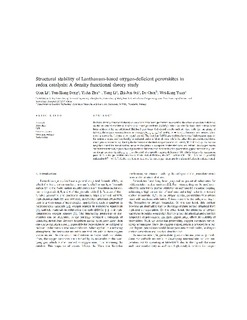| dc.contributor.author | Li, Qian | |
| dc.contributor.author | Deng, Yun-Xiang | |
| dc.contributor.author | Zhu, Yi-An | |
| dc.contributor.author | Li, Yang | |
| dc.contributor.author | Sui, Zhi Jun | |
| dc.contributor.author | Chen, De | |
| dc.contributor.author | Yuan, Wei-Kang | |
| dc.date.accessioned | 2019-04-26T10:43:22Z | |
| dc.date.available | 2019-04-26T10:43:22Z | |
| dc.date.created | 2019-01-27T21:48:03Z | |
| dc.date.issued | 2018 | |
| dc.identifier.citation | Catalysis Today. 2018, 1-8. | nb_NO |
| dc.identifier.issn | 0920-5861 | |
| dc.identifier.uri | http://hdl.handle.net/11250/2595693 | |
| dc.description.abstract | Periodic density functional theory calculations have been performed to examine the effect of oxygen deficiency on the structural stability of Lanthanum-based perovskites (LaMO3), where on-site Coulomb interactions have been addressed by an additional Hubbard-type term. Calculated results indicate that with the exception of LaFeO3, the oxygen vacancy formation energy () of LaMO3 (M = Sc - Cu) becomes less positive when moving across the first transition metal period. The first four LaMO3 perovskites have very high oxygen vacancy formation energies and can hardly be reduced under mild conditions, while the other five perovskites exhibit a much greater reducibility. During the formation of the first oxygen vacancy in LaMO3 (M = Mn - Cu), the nearest neighbor transition-metal cations serve as the primary acceptors of the electrons left behind. As oxygen atoms are further removed, square-based pyramidal and tetrahedral coordination geometries appear successively, and an abrupt increase in is observed at a specific oxygen deficiency (δ), which defines the maximum possible δ in the perovskite structures. Under this definition, the M3+ cations (M = Mn - Ni) can be possibly reduced to M2+ while LaCuO3 may lose at most one lattice oxygen atom per formula unit before it is deactivated. | nb_NO |
| dc.language.iso | eng | nb_NO |
| dc.publisher | Elsevier | nb_NO |
| dc.rights | Attribution-NonCommercial-NoDerivatives 4.0 Internasjonal | * |
| dc.rights.uri | http://creativecommons.org/licenses/by-nc-nd/4.0/deed.no | * |
| dc.title | Structural stability of Lanthanum-based oxygen-deficient perovskites in redox catalysis: A density functional theory study | nb_NO |
| dc.type | Journal article | nb_NO |
| dc.type | Peer reviewed | nb_NO |
| dc.description.version | acceptedVersion | nb_NO |
| dc.source.pagenumber | 1-8 | nb_NO |
| dc.source.journal | Catalysis Today | nb_NO |
| dc.identifier.doi | 10.1016/j.cattod.2018.04.070 | |
| dc.identifier.cristin | 1665813 | |
| dc.description.localcode | © 2018. This is the authors’ accepted and refereed manuscript to the article. Locked until 1.5.2020 due to copyright restrictions. This manuscript version is made available under the CC-BY-NC-ND 4.0 license http://creativecommons.org/licenses/by-nc-nd/4.0/ | nb_NO |
| cristin.unitcode | 194,66,30,0 | |
| cristin.unitname | Institutt for kjemisk prosessteknologi | |
| cristin.ispublished | true | |
| cristin.fulltext | original | |
| cristin.qualitycode | 2 | |

